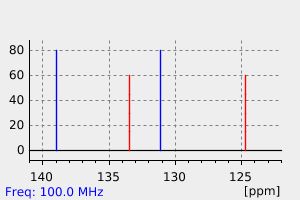4,6-二溴间苯二甲酸 | 24063-27-2
物质功能分类
中文名称
4,6-二溴间苯二甲酸
中文别名
——
英文名称
4,6-dibromoisophthalic acid
英文别名
4,6-dibromobenzene-1,3-dicarboxylic acid;4,6-Dibrom-isophthalsaeure
CAS
24063-27-2
化学式
C8H4Br2O4
mdl
——
分子量
323.925
InChiKey
UDCSURCKPULYEL-UHFFFAOYSA-N
BEILSTEIN
——
EINECS
——
-
物化性质
-
计算性质
-
ADMET
-
安全信息
-
SDS
-
制备方法与用途
-
上下游信息
-
文献信息
-
表征谱图
-
同类化合物
-
相关功能分类
-
相关结构分类
物化性质
-
熔点:250-254 °C
-
沸点:444.9±45.0 °C(Predicted)
-
密度:2.205±0.06 g/cm3(Predicted)
计算性质
-
辛醇/水分配系数(LogP):2.4
-
重原子数:14
-
可旋转键数:2
-
环数:1.0
-
sp3杂化的碳原子比例:0.0
-
拓扑面积:74.6
-
氢给体数:2
-
氢受体数:4
安全信息
-
危险性防范说明:P261,P280,P301+P312,P302+P352,P305+P351+P338
-
危险性描述:H302,H315,H319,H335
SDS
上下游信息
-
上游原料
中文名称 英文名称 CAS号 化学式 分子量 2,4-二溴-5-甲基-苯甲酸 2,4-Dibrom-5-methyl-benzoesaeure 100960-64-3 C8H6Br2O2 293.942 -
下游产品
中文名称 英文名称 CAS号 化学式 分子量 —— dimethyl 4,6-dibromoisophthalate 90766-77-1 C10H8Br2O4 351.979 4,6-二溴间苯二甲酸二乙酯 diethyl 4,6-dibromoisophthalate 915224-50-9 C12H12Br2O4 380.033 —— 4,6-dibromobenzene-1,3-dicarboxylic acid dichloride 91997-32-9 C8H2Br2Cl2O2 360.817
反应信息
-
作为反应物:描述:4,6-二溴间苯二甲酸 在 1,1'-双(二苯基膦)二茂铁 、 tris-(dibenzylideneacetone)dipalladium(0) 、 硫酸 、 盐酸-N-乙基-Nˊ-(3-二甲氨基丙基)碳二亚胺 、 N,N-二异丙基乙胺 作用下, 以 N,N-二甲基甲酰胺 为溶剂, 反应 30.0h, 生成参考文献:名称:Discovery of an all-donor aromatic [2]catenane摘要:一种全供体[2]猫环已通过动态组合化学合成。它具有通过氢键形成准五环的堆叠苯二噻吩结构。DOI:10.1039/d0sc04317f
-
作为产物:描述:2,4-二溴-5-甲基-苯甲酸 在 potassium permanganate 、 potassium hydroxide 作用下, 90.0 ℃ 、101.33 kPa 条件下, 以4.3 g的产率得到4,6-二溴间苯二甲酸参考文献:名称:通过反应模式揭示的 C6-C5-C6-C7-C6 稠合五环芳烃异构体中的单线态双自由基与三线态双自由基/两性离子特征摘要:C 6 -C 5 -C 6 -C 7 -C 6稠合五环芳烃的两种异构体分别嵌入对位和间位醌二甲烷结构基序。这两种化合物表现出独特的反应模式,让人想起单线态和三线态双自由基物种。通过 DFT 计算预测的基态电子结构也与观察到的反应性一致。DOI:10.1002/chem.202102781
文献信息
-
Highly Active Catalysts for the Transfer Dehydrogenation of Alkanes: Synthesis and Application of Novel 7-6-7 Ring-Based Pincer Iridium Complexes作者:Yuan Shi、Takuya Suguri、Chisato Dohi、Hirotsuna Yamada、Satoshi Kojima、Yohsuke YamamotoDOI:10.1002/chem.201203108日期:2013.8.5A series of Ir–PCP pincer precatalysts [(7–6–7‐RPCP)Ir(H)(Cl)] and [(7–6–7‐ArPCP)Ir(H)(Cl)(MeCN)] bearing a novel “7–6–7” fused‐ring skeleton have been synthesized based upon the postulate that the catalytic species would have durability due to their rather rigid structure and high activity owing to the low but sufficient flexibility of their backbones, which are not completely fixed. Treatment of一系列Ir–PCP钳式预催化剂[(7–6–7– R PCP)Ir(H)(Cl)]和[(7–6–7– Ar PCP)Ir(H)(Cl)(MeCN)]根据以下假设合成了带有新型“ 7–6–7”稠环骨架的骨架:由于其主链结构的低而足够的柔韧性,催化物种由于其相当刚性的结构和高活性而具有耐久性。不完全固定。用NaO t Bu处理这些前催化剂会产生活性的14个电子(14e)种类[(7-6--7- i Pr PCP)Ir]和[(7-6-7- Ph PCP)Ir],它们可以捕获氢,并在光谱上表征为四氢化物配合物。[(7–6–7‐ i Pr PCP)Ir]和[[7–6–7–7‐Ph PCP)Ir]被发现在以叔丁基乙烯为氢受体的环辛烷的转移脱氢中非常有效,[(7–6–7– i)在高温(230°C)下的初始反应速率更高Pr PCP)Ir]比[(7–6–7- Ph PCP)Ir]更大,后者的总氢转移率(TON)
-
Superelectrophilic-Initiated C–H Functionalization at the β-Position of Thiophenes: A One-Pot Synthesis of <i>trans</i>-Stereospecific Saddle-Shaped Cyclic Compounds作者:Ying Wei、Xiangping Zheng、Dongqing Lin、Haoxuan Yuan、Zhipeng Yin、Lei Yang、Yang Yu、Shasha Wang、Ling-Hai Xie、Wei HuangDOI:10.1021/acs.joc.9b01233日期:2019.9.6Superelectrophilic-initiated direct C–H functionalization of thiophenes at the β-position was developed. A series of trans-stereospecific [2,1-a]-IF-thiophene-fused cyclic compounds (4) with saddle-shaped structure were prepared in 17–30% yields through a one-pot superelectrophilic Friedel–Crafts reaction of dihydroindenofluorene with thiophene derivatives. From the crystal packing analyses of 4a, its
-
The synthesis of singlet ground state derivatives of non-Kekulé polynuclear aromatics作者:Graeme Allinson、Richard J. Bushby、Malini V. Jesudason、Jean-Louis Paillaud、Norman TaylorDOI:10.1039/a606932k日期:——It is known that a two-electron reduction of tetrabutylammonium 3,4-dioxo-4H,8H-dibenzo[cd,mn]pyren- 12-olate gives a trioxy (tri-O-) derivative of the non-Kekulé polynuclear aromatic compound dibenzo[cd,mn]pyrene (triangulene). This derivative is stable in solution and, like triangulene itself, has a triplet ground state. In exploring the generality of this strategy for the synthesis of high-spin derivatives of non-Kekulé polynuclear aromatic compounds we have investigated two electron reductions of 4,8-dioxo-4H,8H-dibenzo[cd,mn]pyrene (to give a dioxy derivative of triangulene), 7,8-dioxo-7H,8H-dibenzo[de,hi ]naphthacene (to give a dioxy derivative of dibenzo[de,hi]naphthacene) and 7,9-dioxo-7H,9H-dibenzo[de,jk ]pentacene (to give a dioxy derivative of dibenzo[de,jk]pentacene). Dibenzo[cd,mn]pyrene (triangulene), dibenzo[de,hi]naphthacene and dibenzo[de,jk]pentacene should all have triplet ground states, but the presence of two O- substituents on these aromatic nuclei will (just) lift the degeneracy of the putative singly occupied molecular orbitals. We have shown that the splitting this produces is sufficient to ensure that all of these dioxy derivatives have singlet ground states. Hence the strategy employed for making and stabilising triplet triangulene as its trioxy derivative does not provide a paradigm for other high-spin non-Kekulé polynuclear aromatics. The reduction reactions were studied by cyclic voltammetry, by UV–VIS spectroscopy, and by EPR spectroscopy. Improved synthetic routes are described for 7,8-dioxo-7H,8H-dibenzo[de,hi ]naphthacene and for 7,9-dioxo-7H,9H-dibenzo[de,jk ]pentacene. Violent explosions were encountered in attempts to repeat the literature procedure for the synthesis of 4,6-dichlorobenzene-1,3-dicarboxylic acid.已知,四丁基铵3,4-二氧-4H,8H-二苯并[cd,mn]芘-12-olate的二电子还原反应产生非Kekulé多核芳香化合物二苯并[cd,mn]芘(三角烯)的三氧(tri-O-)衍生物。这种衍生物在溶液中稳定,并且像三角烯本身一样,具有三重态基态。在探索这种策略合成非Kekulé多核芳香化合物的高自旋衍生物的普遍性时,我们研究了4,8-二氧-4H,8H-二苯并[cd,mn]芘(产生三角烯的二氧衍生物)、7,8-二氧-7H,8H-二苯并[de,hi]萘并萘(产生二苯并[de,hi]萘并萘的二氧衍生物)和7,9-二氧-7H,9H-二苯并[de,jk]戊搭烯(产生二苯并[de,jk]戊搭烯的二氧衍生物)的二电子还原反应。二苯并[cd,mn]芘(三角烯)、二苯并[de,hi]萘并萘和二苯并[de,jk]戊搭烯都应该具有三重态基态,但这些芳香核上有两个O取代基的存在(恰好)会解除假定的单占据分子轨道的简并性。我们已经证明,这种分裂产生的分裂足以确保所有这些二氧衍生物具有单重态基态。因此,用于制造和稳定三重态三角烯作为其三氧衍生物的策略并不为其他高自旋的非Kekulé多核芳香化合物提供范例。还原反应通过循环伏安法、紫外-可见光谱和电子顺磁共振光谱进行了研究。还描述了7,8-二氧-7H,8H-二苯并[de,hi]萘并萘和7,9-二氧-7H,9H-二苯并[de,jk]戊搭烯的改进合成路线。在尝试重复文献中4,6-二氯苯-1,3-二羧酸的合成步骤时,遭遇了剧烈的爆炸。
-
MODIFIER FOR AROMATIC POLYESTER AND AROMATIC POLYESTER RESIN COMPOSITION COMPRISING THE SAME申请人:TABATA Masayoshi公开号:US20110224343A1公开(公告)日:2011-09-15The present invention provides a modifier for aromatic polyesters which enhances the melt fluidity of aromatic polyesters without a significant decrease in the heat resistance of the aromatic polyesters, and an aromatic polyester resin composition including the modifier for aromatic polyesters. The present invention relates to a modifier for aromatic polyesters comprising polyhydric phenol residues and residues of aromatic polycarboxylic acid, acid halide or acid anhydride thereof, and the modifier comprises a material having a structure composed of a first residue selected from the group consisting of divalent residues represented by Formula (I): —Ar—W 1 x —Ar— and by Formula (II): —Ar—, the first residues being bonded to two identical or different second residues selected from the group consisting of monovalent residues represented by Formula (III): and monovalent residues represented by Formula (IV): —O—C(O)—R 7 —.
-
Anion Recognition in Water by Charge-Neutral Halogen and Chalcogen Bonding Foldamer Receptors作者:Arseni Borissov、Igor Marques、Jason Y. C. Lim、Vítor Félix、Martin D. Smith、Paul D. BeerDOI:10.1021/jacs.9b00148日期:2019.3.6multiple σ-hole-anion interactions and hydrophobic collapse results in I- affinities in water that exceed all known σ-hole receptors, including cationic systems (β2 up to 1.68 × 1011 M-2). Furthermore, the anion binding affinities and selectivity trends of the first example of an all-chalcogen bonding anion receptor in pure water are compared with halogen bonding and hydrogen bonding receptor analogues首次展示了一种使用电荷中性 σ 孔卤素和硫属元素键合无环主体识别水中阴离子的新策略。利用卤素和硫属元素键供体原子的固有疏水性,集成到包含亲水功能的折叠体结构分子框架中,构建了一系列水溶性受体用于阴离子识别研究。对一系列阴离子进行的等温滴定量热 (ITC) 结合研究表明,受体对大的弱水合阴离子(如 I- 和 ReO4-)表现出非常强的选择性结合。这是通过形成 2:1 的主客体化学计量复杂组件来实现的,从而产生由协同、多齿、会聚的 σ 空穴供体稳定的封装阴离子,如在水中进行的分子动力学模拟所示。重要的是,多个 σ-hole-阴离子相互作用和疏水塌陷的组合导致水中的 I-亲和力超过所有已知的 σ-hole 受体,包括阳离子系统(β2 高达 1.68 × 1011 M-2)。此外,将纯水中全硫属键阴离子受体的第一个例子的阴离子结合亲和力和选择性趋势与卤素键和氢键受体类似物进行了比较。这些结果进一步
表征谱图
-
氢谱1HNMR
-
质谱MS
-
碳谱13CNMR
-
红外IR
-
拉曼Raman
-
峰位数据
-
峰位匹配
-
表征信息
同类化合物
(βS)-β-氨基-4-(4-羟基苯氧基)-3,5-二碘苯甲丙醇
(S,S)-邻甲苯基-DIPAMP
(S)-(-)-7'-〔4(S)-(苄基)恶唑-2-基]-7-二(3,5-二-叔丁基苯基)膦基-2,2',3,3'-四氢-1,1-螺二氢茚
(S)-盐酸沙丁胺醇
(S)-3-(叔丁基)-4-(2,6-二甲氧基苯基)-2,3-二氢苯并[d][1,3]氧磷杂环戊二烯
(S)-2,2'-双[双(3,5-三氟甲基苯基)膦基]-4,4',6,6'-四甲氧基联苯
(S)-1-[3,5-双(三氟甲基)苯基]-3-[1-(二甲基氨基)-3-甲基丁烷-2-基]硫脲
(R)富马酸托特罗定
(R)-(-)-盐酸尼古地平
(R)-(-)-4,12-双(二苯基膦基)[2.2]对环芳烷(1,5环辛二烯)铑(I)四氟硼酸盐
(R)-(+)-7-双(3,5-二叔丁基苯基)膦基7''-[((6-甲基吡啶-2-基甲基)氨基]-2,2'',3,3''-四氢-1,1''-螺双茚满
(R)-(+)-7-双(3,5-二叔丁基苯基)膦基7''-[(4-叔丁基吡啶-2-基甲基)氨基]-2,2'',3,3''-四氢-1,1''-螺双茚满
(R)-(+)-7-双(3,5-二叔丁基苯基)膦基7''-[(3-甲基吡啶-2-基甲基)氨基]-2,2'',3,3''-四氢-1,1''-螺双茚满
(R)-(+)-4,7-双(3,5-二-叔丁基苯基)膦基-7“-[(吡啶-2-基甲基)氨基]-2,2”,3,3'-四氢1,1'-螺二茚满
(R)-3-(叔丁基)-4-(2,6-二苯氧基苯基)-2,3-二氢苯并[d][1,3]氧杂磷杂环戊烯
(R)-2-[((二苯基膦基)甲基]吡咯烷
(R)-1-[3,5-双(三氟甲基)苯基]-3-[1-(二甲基氨基)-3-甲基丁烷-2-基]硫脲
(N-(4-甲氧基苯基)-N-甲基-3-(1-哌啶基)丙-2-烯酰胺)
(5-溴-2-羟基苯基)-4-氯苯甲酮
(5-溴-2-氯苯基)(4-羟基苯基)甲酮
(5-氧代-3-苯基-2,5-二氢-1,2,3,4-oxatriazol-3-鎓)
(4S,5R)-4-甲基-5-苯基-1,2,3-氧代噻唑烷-2,2-二氧化物-3-羧酸叔丁酯
(4S,4''S)-2,2''-亚环戊基双[4,5-二氢-4-(苯甲基)恶唑]
(4-溴苯基)-[2-氟-4-[6-[甲基(丙-2-烯基)氨基]己氧基]苯基]甲酮
(4-丁氧基苯甲基)三苯基溴化磷
(3aR,8aR)-(-)-4,4,8,8-四(3,5-二甲基苯基)四氢-2,2-二甲基-6-苯基-1,3-二氧戊环[4,5-e]二恶唑磷
(3aR,6aS)-5-氧代六氢环戊基[c]吡咯-2(1H)-羧酸酯
(2Z)-3-[[(4-氯苯基)氨基]-2-氰基丙烯酸乙酯
(2S,3S,5S)-5-(叔丁氧基甲酰氨基)-2-(N-5-噻唑基-甲氧羰基)氨基-1,6-二苯基-3-羟基己烷
(2S,2''S,3S,3''S)-3,3''-二叔丁基-4,4''-双(2,6-二甲氧基苯基)-2,2'',3,3''-四氢-2,2''-联苯并[d][1,3]氧杂磷杂戊环
(2S)-(-)-2-{[[[[3,5-双(氟代甲基)苯基]氨基]硫代甲基]氨基}-N-(二苯基甲基)-N,3,3-三甲基丁酰胺
(2S)-2-[[[[[((1S,2S)-2-氨基环己基]氨基]硫代甲基]氨基]-N-(二苯甲基)-N,3,3-三甲基丁酰胺
(2S)-2-[[[[[[((1R,2R)-2-氨基环己基]氨基]硫代甲基]氨基]-N-(二苯甲基)-N,3,3-三甲基丁酰胺
(2-硝基苯基)磷酸三酰胺
(2,6-二氯苯基)乙酰氯
(2,3-二甲氧基-5-甲基苯基)硼酸
(1S,2S,3S,5S)-5-叠氮基-3-(苯基甲氧基)-2-[(苯基甲氧基)甲基]环戊醇
(1S,2S,3R,5R)-2-(苄氧基)甲基-6-氧杂双环[3.1.0]己-3-醇
(1-(4-氟苯基)环丙基)甲胺盐酸盐
(1-(3-溴苯基)环丁基)甲胺盐酸盐
(1-(2-氯苯基)环丁基)甲胺盐酸盐
(1-(2-氟苯基)环丙基)甲胺盐酸盐
(1-(2,6-二氟苯基)环丙基)甲胺盐酸盐
(-)-去甲基西布曲明
龙蒿油
龙胆酸钠
龙胆酸叔丁酯
龙胆酸
龙胆紫-d6
龙胆紫







